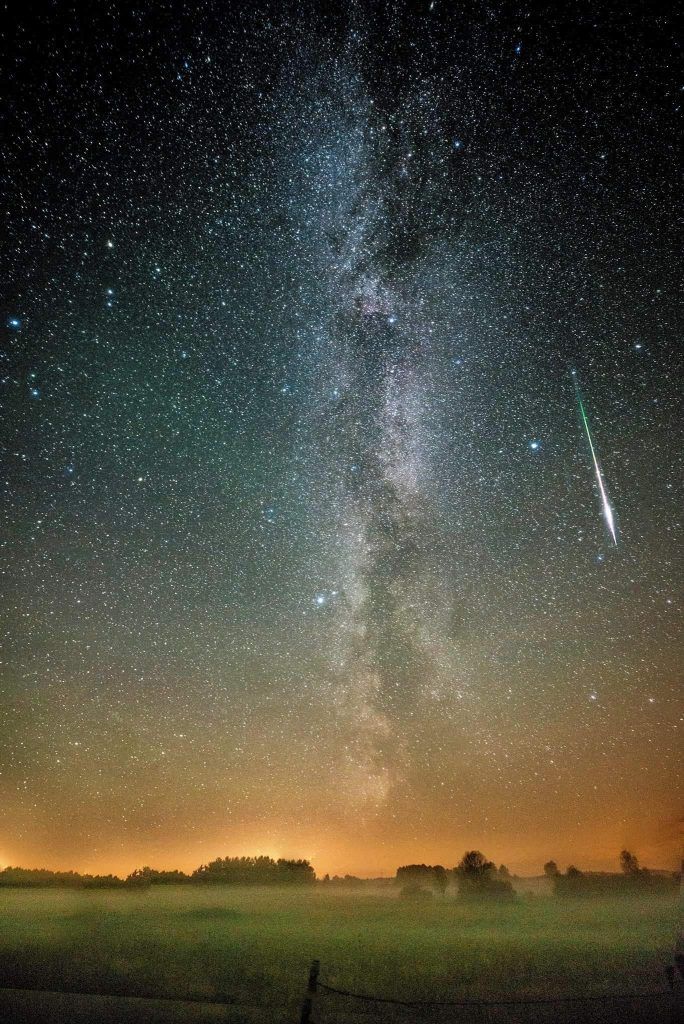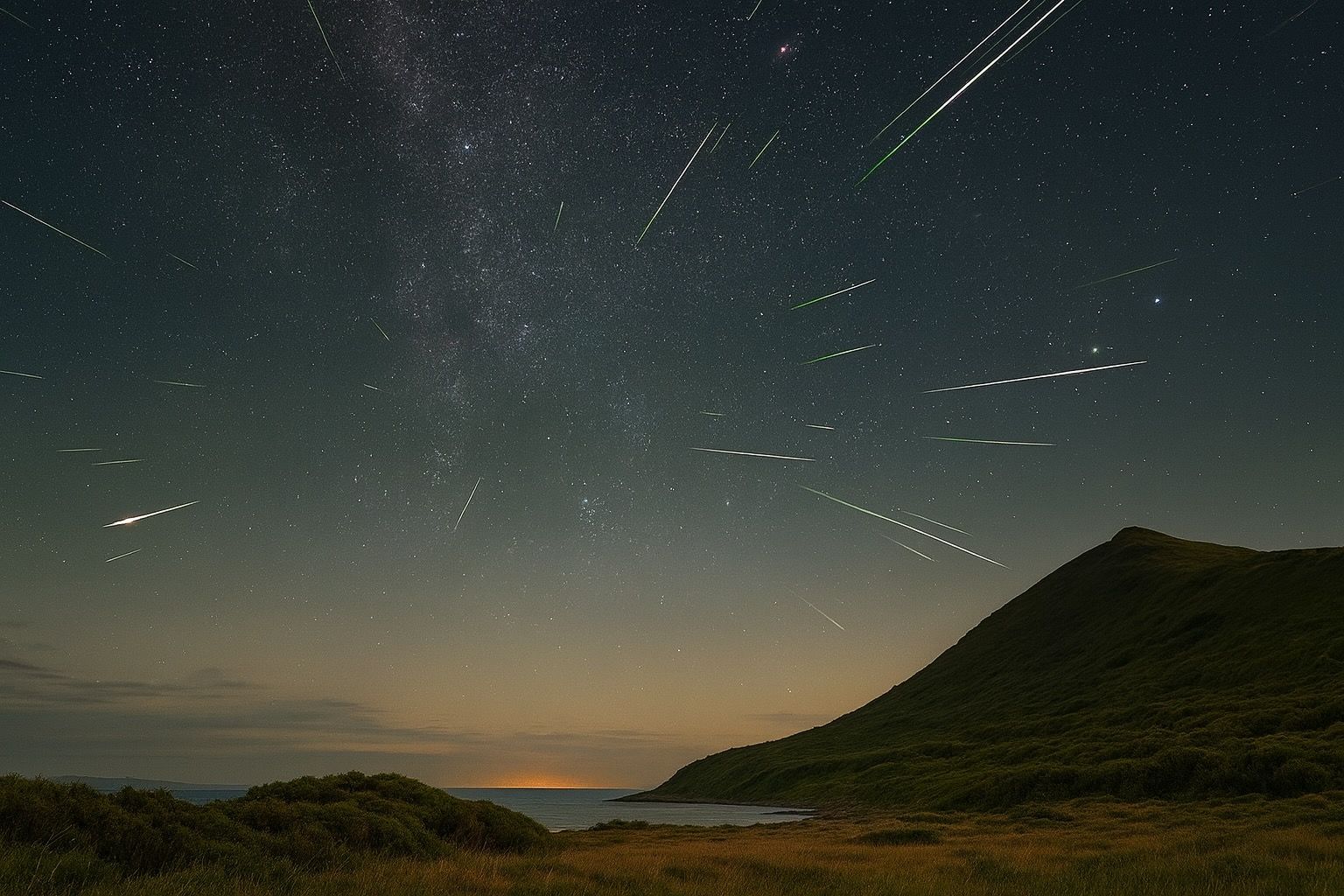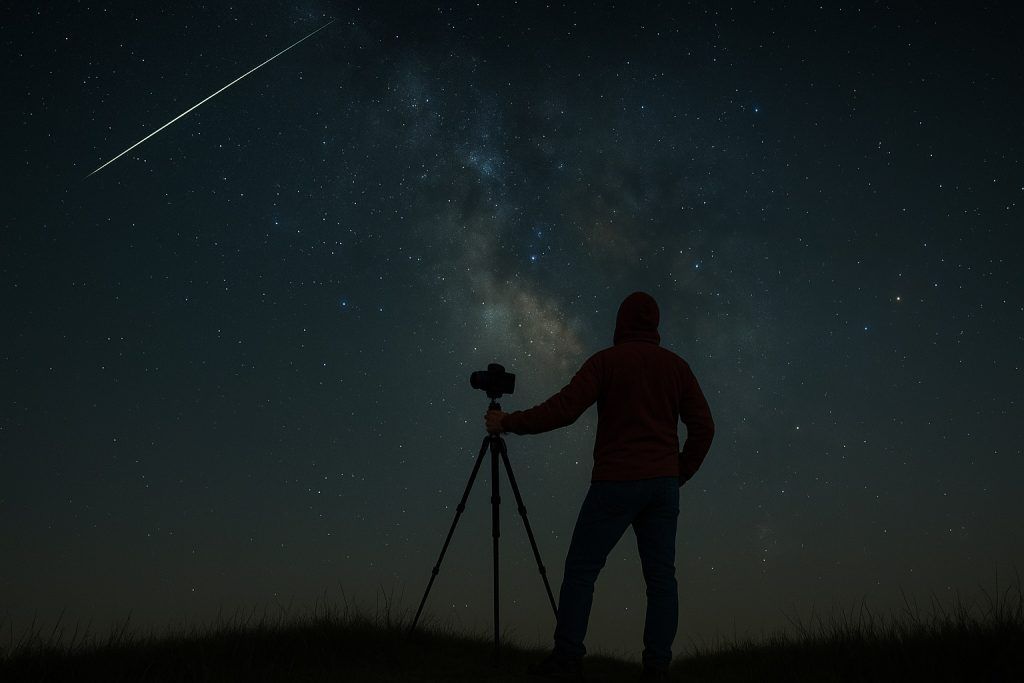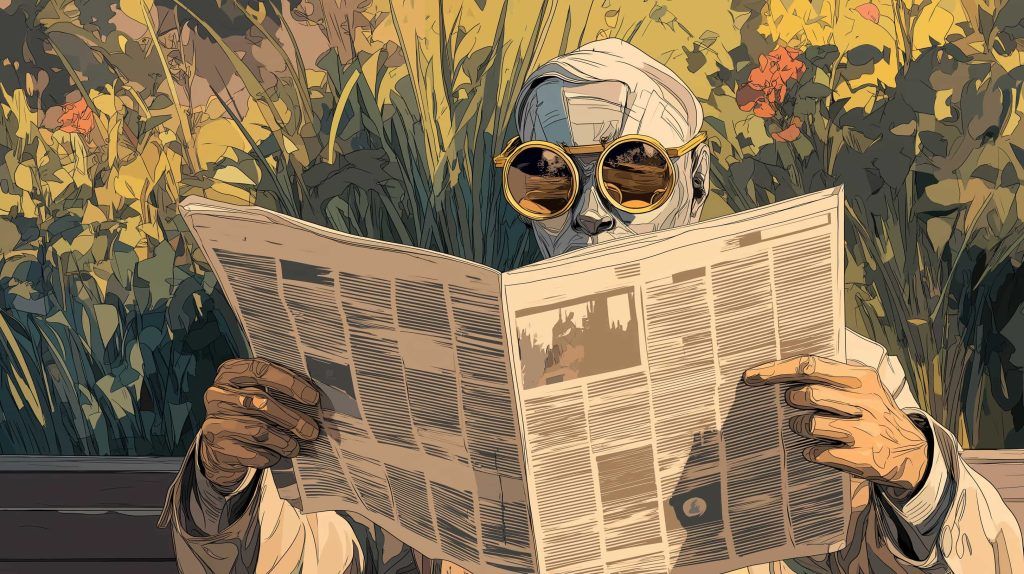- The Perseids peak on August 12–13, 2025, as Earth passes through the densest part of Swift-Tuttle’s debris, with the official peak around 02:30–03:00 UTC on August 13.
- The Moon will be a bright waning gibbous at about 83–84% illumination during peak, severely reducing counts from the typical 50–100 meteors per hour to about 10–20 per hour.
- The best viewing times are after midnight local time, with NASA noting a prime window around 2–3 a.m. local time.
- The radiant lies in the constellation Perseus, near the Perseus–Cassiopeia border, so many meteors appear to radiate from that area.
- The shower’s material comes from comet 109P/Swift-Tuttle, a ~26-km nucleus that orbits the Sun about every 133 years and last passed the inner solar system in 1992.
- Perseid fireballs are a hallmark; NASA and Sky & Telescope highlight the shower as the “fireball champion” with bright fireballs sometimes rivaling Venus.
- The shower is visible from virtually the entire Northern Hemisphere, with darker rural sites yielding the best rates, while observers in the Southern Hemisphere see far fewer meteors.
- If the Moon is up, position yourself to block or avoid direct Moonlight (e.g., in moonshadow) and give your eyes 20–30 minutes to dark-adapt before counting meteors.
- No telescope is needed and the naked eye is best, though a fast wide-angle lens on a tripod with 20–30 second exposures can capture Perseids.
- Public events and livestreams include a Virtual Telescope Project webcast on August 12, 2025 at 21:00 UTC, plus local star parties such as the Big Bear Valley Astronomical Society event on August 16 and Chabot Space & Science Center programs.
A bright Perseid meteor streaks across the starry night sky. The Perseids are famous for producing occasional fireballs – extra-bright meteors that can outshine planets.
Overview: A Beloved Meteor Shower Under Moonlight Challenge
Every August, skywatchers look forward to the Perseid meteor shower, one of the year’s most reliable and beloved celestial displays. In 2025, the Perseids will peak around August 12–13, with activity continuing for weeks on either side [1] [2]. However, this year comes with a twist – a bright waning gibbous moon will rise during the prime meteor hours and wash out many faint meteors [3] [4]. Don’t be discouraged: with a bit of planning, you can still catch the “shooting stars” of the Perseids, including the impressive fireballs that make this shower the “fireball champion” of annual meteor showers [5]. Below, we’ll cover when and where to watch for the best views, what to expect (even under less-than-ideal conditions), tips for optimal viewing, the science and lore behind the Perseids, and info on any special events or livestreams so you won’t miss the show.
Peak Dates and Best Times in 2025
The Perseids of 2025 are active from mid-July to late August, but the peak comes in mid-August. Mark your calendar for the night of August 12–13, 2025 – that’s when Earth passes through the densest part of comet Swift-Tuttle’s debris stream, producing the most meteors [6]. The predicted peak occurs around 02:30–03:00 UTC on August 13 (which is 4:30–5:00 a.m. Central European Summer Time, and late evening of Aug 12 in North America) [7] [8]. This timing means Europe and parts of Africa get peak activity in their pre-dawn hours, while observers in North America will be viewing a few hours before the absolute peak (still a great show in the hours before dawn) [9]. Asia and Australia will miss the exact peak (which falls in their daytime), but should still watch on the nights around Aug 12–13 when meteor rates are high.
What is the best time of night? Meteor rates build up as the night goes on. The Perseids’ radiant (in the constellation Perseus) rises late in the evening and climbs higher through the early morning hours [10] [11]. Therefore, the most meteors are seen in the dark hours after midnight, through dawn. In fact, NASA notes the prime time is around 2–3 a.m. local time wherever you are [12]. “You’re not going to see Perseids around suppertime,” quips Bill Cooke of NASA’s Meteoroid Environment Office. “You’re going to have to go out later” [13]. So plan for a late night or pre-dawn outing if possible. (If you can’t stay up late, you might catch a few meteors as early as 10 p.m., but the counts will be much lower [14] [15].)
Moonlight alert: Unfortunately, in 2025 the moon will be a major factor. The peak nights fall just a few days after a full moon (the Moon will be ~83–84% illuminated in a waning gibbous phase) [16] [17]. This means moonlight will act as natural light pollution, washing out fainter meteors. The American Meteor Society (AMS) cautions that bright moonlight will “severely compromise” the Perseids at peak, reducing visible meteor counts by at least 75% [18]. In practical terms, instead of the ~50–100 meteors per hour you might see under perfect dark skies in a good year, you may only spot on the order of 10–20 meteors per hour at peak in 2025 [19] [20]. “Only the brighter meteors will be visible,” AMS expert Robert Lunsford explains, since moonlight overwhelms the faint streaks [21]. Don’t be deterred – those 10–20 meteors can still include spectacular fireballs that punch through the moon’s glare [22]. But it’s important to manage expectations: 2025 is considered a challenging year for the Perseids due to lunar conditions [23] [24].
Tip: If the moon is up, you can improve your experience by watching from moonshadow – position yourself so that a building, hill, or trees block the moon from your direct view. As Bill Cooke advises, “Look anywhere but at the Moon” to help preserve your night vision and catch more meteors [25]. The moon will rise in late evening, so you might also try catching meteors in the early evening before moonrise on days just before the peak, or a few nights after the peak when the moon wanes (though the meteor rates will be dropping then). A planetarium expert suggests going out about a week after peak (once the moon is much dimmer) to still see some Perseids without lunar interference [26].
Where to Watch: Best Locations and Global Viewing Regions
One great thing about the Perseids is that they are visible from virtually the entire Northern Hemisphere. The shower’s radiant is in northern skies, so Northern Hemisphere observers get the best show, especially in mid-latitude regions (e.g. North America, Europe, most of Asia) [27]. In these areas, Perseus rises reasonably high, and you could normally see dozens of meteors per hour under dark skies. Southern Hemisphere observers, on the other hand, will see far fewer Perseids – if you live below roughly 30° south latitude, Perseus stays very low or below the horizon. Those in the tropical or subtropical Southern Hemisphere (e.g. northern Australia, South Africa, or Argentina) might catch some Perseids if they have a clear view toward the northern horizon in the pre-dawn hours, but expect lower rates.

To maximize your Perseid viewing, you’ll need a dark and clear location. City dwellers should plan a trip if possible – even a short drive to the suburbs or countryside can greatly increase the number of meteors visible by escaping urban light pollution. “To view the Perseids successfully, it is suggested you watch from a safe rural area that is as dark as possible. The more stars you can see, the more meteors will also be visible,” advises the AMS’s Robert Lunsford [28]. In practice, that means getting away from streetlights, buildings, and haze. Regional weather matters too: pick a location known for clear skies in August. (For example, areas with desert or mountain climates often have transparent skies, whereas some regions like Southeast Asia have monsoon clouds in August.)
If you’re in Europe, be aware that much of the continent suffers from heavy light pollution (as seen in satellite images of Europe at night). Dark-sky reserves and parks are oases for stargazing. For instance, the Cévennes National Park in France and the Pic du Midi area in the Pyrenees are certified dark-sky destinations renowned for starry skies [29]. The Northumberland Dark Sky Park in northern England, parts of rural Scandinavia, and areas in the Carpathian Mountains or Pyrenees offer excellent viewing conditions. Many European countries have designated International Dark Sky Parks – from Snowdonia in Wales to Zselic Park in Hungary – which can be ideal for meteor observing [30] [31]. In the United States and Canada, vast rural areas and national parks in the West (for example, places like Bryce Canyon, Utah, or Grasslands National Park in Saskatchewan) provide wonderfully dark skies. Even near big cities, you can often find darker pockets – for example, in California, astronomers head to the mountains or deserts; on the U.S. East Coast, areas like Maine or parts of the Appalachians have darker sky preserves. If you can travel, one handy tool is an online light pollution map, which shows glow intensity; you’ll want to avoid the bright red/orange zones on the map and aim for gray or black zones indicating the least light pollution [32] [33].
Satellite composite of Europe at night highlighting areas of heavy light pollution (bright urban areas). To see more Perseids, find a location away from city lights – ideally in one of the dark regions on the map.
No matter where you are, safety and comfort are key. Choose an observing spot that is safe and accessible at night (e.g. a campground, park, or backyard with open sky). Make sure you have permission if it’s private land. Check that the view of the sky is wide-open – an ideal site has an unobstructed 360° view with minimal trees or buildings, so you can scan as much sky as possible. If you’re stuck in a city, try to find a large park or rooftop with the darkest conditions available, and turn off or block any nearby lights (even something as simple as positioning yourself in a shadow of a building can help). In all cases, watch the weather forecast: clear skies are a must. If the peak night forecast is cloudy, consider watching on an earlier or later clear night; the Perseids are active for weeks, and you might still see some meteors a few nights before or after the peak when skies clear up (though rates will be lower).
What You’ll See: Meteors, Fireballs, and More
Expect to see “shooting stars” streaking across the sky – these are the meteors, bits of comet debris burning up in Earth’s atmosphere. During the Perseids’ peak under perfect conditions, you could normally see up to 60–90 meteors per hour or more [34]. In 2025, with moonlight, the visible rate will be reduced, so seeing ~10 or more meteors in an hour is a reasonable outcome [35] [36]. Remember, meteor showers are a bit like fishing: you might see bursts of several meteors in quick succession, then a lull for a few minutes. Be patient – over the course of a night (or the early morning hours), the numbers add up.
The Perseids are known for being colorful and for leaving persistent trains (glowing trails that linger briefly after the meteor) [37]. Many Perseid meteors are fast and medium-bright, appearing as quick streaks. But the shower is also famous for its fireballs – extra-bright meteors that can rival Venus in brilliance and even cast shadows [38]. In fact, NASA’s Bill Cooke notes that the Perseids tend to produce more fireballs than any other annual shower, thanks to the larger pieces of debris from its parent comet [39]. A bright Perseid fireball can light up the sky with a flash of green or orange and may leave a glowing ionization trail that lasts several seconds. If you’re lucky, you might witness one of these memorable meteors that draw gasps from onlookers.
Meteors will appear in all parts of the sky, so you don’t need to fixate on one spot. It’s fun to know where they originate: if you trace back the paths of the Perseids you see, they will appear to radiate from the direction of the constellation Perseus (near the Perseus/Cassiopeia border) [40] [41]. This point in the sky is called the radiant of the shower. You may notice that meteors farther from the radiant tend to have longer trails, while those appearing near Perseus are shorter “streaks” (due to perspective). Pro tip: If you spot a meteor, mentally draw a line backwards – if it leads to Perseus, you’ve confirmed it was a Perseid. (If not, it may have been a sporadic meteor or from another minor shower.) That said, don’t stare only at Perseus – you’ll miss meteors overhead or behind you. It’s best to relax and take in as wide a view of the sky as possible; Perseids can streak anywhere.
You won’t need any special equipment – no telescope or binoculars required! In fact, using those would hurt your meteor spotting, because they severely limit your field of view. The Royal Observatory astronomers emphasize that “binoculars and telescopes are not necessary as they will restrict the size of the sky that will be visible to you.” [42] [43] The naked eye is the best instrument for meteor showers. However, a few simple tools can enhance the experience:
- A star chart or mobile astronomy app (in night mode) can help you identify constellations and the Perseid radiant in Perseus [44] [45]. Apps like Stellarium, SkySafari, Sky Guide, Star Walk, etc., can be set to red “night mode” to preserve your night vision. It’s enjoyable to see where Perseus is and to know the general area meteors are radiating from – plus you can spot planets (note: in August 2025, Venus and Jupiter form a striking pair in the pre-dawn east during the Perseid peak mornings [46]).
- Binoculars are not useful for viewing meteors (since meteors move too fast and appear randomly). But you can use binoculars to observe other celestial sights while waiting – for example, scan the Milky Way star fields, or take a look at Jupiter’s moons or Saturn if they’re up. During lulls in the meteor shower, a quick peek at these can enrich your night.
- If you’re interested in photographing the meteors, bring a camera with manual settings, a fast wide-angle lens, and a tripod. You can set it to take repeated long exposures (20–30 seconds) pointed at the sky; with luck, some Perseids will streak through your shots. Even some modern smartphones have a “night mode” or long exposure apps that might catch a bright meteor if aimed properly. (Photographing meteors is a bit advanced, but the Perseids do provide some spectacular photo opportunities – for instance, one photographer captured 101 Perseids in one night by stacking images [47]!)
Tips for Optimal Viewing
To make the most of your Perseid-watching experience, keep these viewing tips in mind:
- Find the Darkest Sky Possible: Get away from city lights. Head to the countryside or a dark-sky park if you can. The more stars you can see with your naked eye, the more meteors you’ll catch [48]. Avoid looking at any white lights (phone screens, flashlights, or car headlights) during your observing – they will ruin your night vision instantly. If you need light, use a red flashlight or put red cellophane over a regular flashlight [49].
- Check the Weather and Be Prepared: A clear sky is essential – clouds will block the show. Use weather forecasts to choose a cloud-free night or location. If forecast looks bad on the peak night, try the night before or after. Also, plan for the temperature: even in August, nights can get chilly in the early morning hours. Dress in layers and bring a warm jacket or blanket, especially if you’ll be out in the pre-dawn when temperatures drop [50] [51].
- Get Comfortable & Settle In: Meteors can appear at any time, and your eyes take ~20–30 minutes to fully adapt to darkness. Bring a reclining lawn chair, sleeping pad, or blanket to lie back on [52]. Make sure you can gaze upward without craning your neck. Perhaps elevate your head slightly to stay alert [53]. Have some snacks and a thermos of a warm drink on hand for energy – meteor watching is a waiting game, so a hot chocolate or tea and some treats can keep you comfortable and happy during the vigil [54] [55].
- Avoid the Moon (and Other Lights): In 2025, the bright moon is a big factor. If the Moon is above the horizon while you’re observing, try to position yourself so that the Moon is at your back or hidden by an obstacle [56]. This will help keep your eyes adapted. Similarly, shield yourself from any nearby lights. Once your eyes are dark-adapted, even a brief flash of white light (phone, flashlight, car interior light) can dramatically set back your night vision.
- Look Up, Scan Wide, and Be Patient: You don’t need any optical aid – just your eyes. Let them roam the sky. You might focus roughly ~45° to 90° away from the radiant (Perseus) for the best chance of long meteor trails, but in truth meteors can appear anywhere overhead. If you have friends or family with you, spread out your gaze in different directions and call out when someone sees one. Plan to watch for at least an hour – meteor activity can be clumpy, and a longer watch increases your chances of seeing some great meteors. Relax and enjoy the experience of the night sky; even between meteors, you’ll get to see stars, planets, and maybe the Milky Way band if your site is dark enough.
- Enhance the Experience: Consider bringing a star map or astronomy app to identify stars and planets (just keep it in night mode to preserve vision). You can also make it an event: pack a picnic, invite friends, and turn off electronics for a while to fully soak in the awe of the cosmos. Some people like to count meteors and make it a fun challenge (“Who saw the most?”). You could even contribute to science by counting and reporting meteors to organizations like the IMO or AMS via their meteor logging apps.
- Safety First: Late-night stargazing is wonderful, but ensure your personal safety. Choose a location that is safe and legal to be at after dark. If it’s remote, go with a small group if possible. Bring a headlamp (with red light mode) for packing up. If in wilderness areas, be aware of wildlife. Also, remember to pack out what you pack in, and be respectful of nature and other observers (use red lights, keep noise low).
The Science Behind the Perseids: What Causes “Shooting Stars”?
Meteor showers are a beautiful intersection of Earth’s orbit and cometary debris. The Perseids occur when Earth passes through a stream of debris left by the comet 109P/Swift-Tuttle [57] [58]. Each year from mid-July to late August, our planet’s path crosses this broad trail of dust and tiny rocks that the comet has shed over many orbits. These particles – typically no bigger than grains of sand or pebbles – slam into Earth’s atmosphere at tremendous speed (Perseid meteoroids hit at about 59 km/s, or over 130,000 mph!) [59] [60]. Hitting the atmosphere at such velocity, each particle compresses and superheats the air in front of it, creating a brilliant streak of hot ionized gas – what we see as a meteor [61]. The vast majority of Perseid meteors vaporize completely at high altitudes (~80–100 km above the ground) [62]. They do not hit the ground, so you won’t be finding Perseid meteorites – the debris is too fragile and burns up entirely (meteorites mostly come from sturdier rocks or asteroids) [63].
The Perseids are named for the constellation Perseus because that’s where their radiant lies, but there’s no physical connection to the stars of Perseus – it’s purely a line-of-sight effect [64]. The actual source is the comet Swift-Tuttle, a roughly 26 km wide comet nucleus discovered in 1862 by Lewis Swift and Horace Tuttle [65] [66]. Swift-Tuttle orbits the Sun every ~133 years, venturing from the outer solar system into the inner solar system. Each time it approaches the Sun, it heats up and releases clouds of dust and gravelly bits. Over millennia, those bits spread out along the comet’s orbit. Earth plows through this cosmic litter every year. Notably, Swift-Tuttle last visited the inner solar system in 1992, which gave the Perseids a notable boost in the early 1990s [67]. (Some older skywatchers might recall the exceptional Perseids of 1993, which had unusual outbursts thanks to fresh material from the comet’s 1992 passage.) The comet won’t return until 2126, but the debris we encounter each year is still there, delivering the annual show [68] [69].
It was an astronomer named Giovanni Schiaparelli who first realized the link between the Perseid meteor shower and Swift-Tuttle’s orbit. Shortly after the comet’s discovery, in the late 1860s, Schiaparelli calculated that the orbit of Swift-Tuttle matched the trajectory of the Perseid meteors, confirming that cometary debris causes meteor showers [70]. This was a breakthrough in understanding that comets are the “parents” of meteor showers.
Humans have been observing the Perseids for a long time. Ancient records from East Asia mention increased meteors in mid-August – Chinese texts as far back as 36 AD noted meteors around this time of year [71]. However, it wasn’t until the 19th century that Western scientists recognized the annual nature of the Perseids. Adolphe Quetelet in 1835 identified that there was a shower recurring each August from the direction of Perseus [72]. Interestingly, in European folklore, the Perseids gained the name “The Tears of St. Lawrence.” Saint Lawrence’s feast day falls on August 10th, around the peak of the shower, and in medieval times people poetically imagined the meteors were the fiery tears of the martyred saint raining down from heaven [73] [74]. (Saint Lawrence was executed in August 258 AD – the timing coincided with the meteor shower, leading to this traditional name, especially in Catholic Europe.) This evocative nickname persists in some cultures.
So as you watch the 2025 Perseids, remember you’re witnessing a bit of cosmic history and science: tiny remnants of a comet’s tail hitting our atmosphere at hyperspeed. Each streak is a bit of ancient dust, perhaps released from Swift-Tuttle hundreds or thousands of years ago, now burning up in a final moment of glory for your enjoyment. It’s quite poetic – no wonder the Perseids have inspired myths and legends for centuries!
Expert Insights and Quotes
Astronomy organizations and experts often share advice for enjoying the Perseids:
- The American Meteor Society emphasizes the effect of moonlight in 2025, noting “the waning gibbous moon will severely compromise this shower at the time of maximum activity” and estimating that observers might only see 25% of the usual meteors (around 10–20 per hour) due to the bright moon [75] [76]. In general, the darker your sky, the closer you’ll get to the higher end of that range.
- NASA meteor expert Bill Cooke points out the Perseids’ timing and the need for late-night viewing. As he colorfully puts it, “You’re not going to see Perseids around suppertime… You’re going to have to go out later.” And once you do, he advises picking a safe, dark viewing spot and looking “anywhere but at the Moon” to maximize your chances [77]. Cooke also calls the Perseids the “fireball champion” of meteor showers due to their propensity for bright meteors [78], so even a moon-diminished Perseid display can surprise you with the occasional brilliant streak.
- Royal Observatory Greenwich astronomers remind viewers that the Perseids are “one of the best meteor showers of the year because it produces bright meteors and is one of the most active” [79]. Even in a sub-par year, the Perseids’ consistency and numerous fireballs make them worthwhile. They also stress that no fancy equipment is needed – a comfortable eye and dark sky are your best tools [80].
- Many seasoned observers suggest watching on multiple nights if you can. Since meteor rates ramp up in early August and only gradually decline after the peak, you can try a night before the peak (with a nearly full moon but building activity) and a night after the peak (fewer meteors but a slightly later moonrise or phase). You might find the best balance of dark sky and meteor count by adjusting your outing by a few days if the absolute peak night is too bright or cloudy. As one planetarium director noted, the Perseids “are an incredible meteor shower” – so catching even a modest display can be thrilling [81] [82].
Public Events, Livestreams, and Further Resources
The Perseids’ popularity means that public viewing events are held in many areas. Astronomy clubs, science centers, and parks often organize “meteor shower watch” nights or star parties around the peak. For example, in 2025 the Big Bear Valley Astronomical Society in California scheduled a public Perseid star party on August 16 (just after peak) [83], and the Chabot Space & Science Center (East Bay, California) planned a late-night watch on the peak night for visitors [84]. Check your local astronomy club or planetarium to see if they’re hosting a Perseid viewing – it can be fun to share the experience (and experts on hand can answer questions or point out constellations with lasers). In Europe, organizations like the UK’s Royal Astronomical Society or local observatories sometimes hold Perseid gatherings or even overnight camping events at dark-sky sites. Many national parks also welcome visitors for meteor showers – some U.S. National Parks, for instance, have ranger-led night sky programs during the Perseids.
If you can’t get to a dark site or the weather doesn’t cooperate, you can still enjoy the Perseids online. Several observatories and groups offer livestreams of the meteor shower. One notable online event is by the Virtual Telescope Project in Italy: astronomer Gianluca Masi will host a Perseids live webcast on August 12, 2025, starting at 21:00 UTC (5:00 p.m. EDT) [85]. This stream will use wide-field video cameras to pick up meteors in the sky, so you can watch the show in real time from wherever you are. NASA’s Meteor Watch social media might also share live images or counts from its all-sky cameras. Additionally, the IMO (International Meteor Organization) often provides near-real-time meteor rate counts on its website, so you can see how the shower is performing.
For further reading and planning: NASA’s “Watch the Skies” blog and the American Meteor Society website are excellent sources of up-to-date information on meteor showers. The AMS Meteor Shower Calendar [86] gives predictions for peak times and viewing conditions for all major showers (including their notes on the 2025 Perseids and moon interference). EarthSky.org and Space.com also publish annual Perseid guides with tips, and often have community photos from around the world after the event – great for seeing what others observed. If you’re curious about the science, the IMO and even academic papers (for the truly enthusiastic) detail how meteor showers are forecast and studied.
Lastly, don’t forget to enjoy the moment. Watching the Perseids is a chance to connect with the night sky in a meaningful way. Bring friends or family, make some wishes on “shooting stars,” and take a moment to appreciate the Earth moving through a comet’s ancient trail. Clear skies and happy meteor watching!
Sources:
- EarthSky – Perseid meteor shower 2025: All you need to know [87] [88] [89]
- NASA Watch the Skies – Bright Moonlight Could Interfere with View of Perseids’ Peak [90] [91] [92]
- American Meteor Society – Meteor Shower Calendar 2025 (via CBS News quotes) [93] [94] [95]
- Royal Observatory Greenwich – Perseid Meteor Shower 2025 Guide [96] [97]
- Euronews – Perseids 2025: All you need to know… [98] [99] [100]
- ScienceAlert/Universe Today – The Perseids Peak This Week: When to Look Up [101] [102] [103]
- Sky & Telescope – Fireball Champion of Meteor Showers [104] (Bill Cooke quote)
- CBS News – Perseid meteor shower will peak this week… [105] [106] [107]
- NASA/Bill Ingalls – Perseid meteor image (public domain) [108]
References
1. earthsky.org, 2. www.cbsnews.com, 3. earthsky.org, 4. www.cbsnews.com, 5. skyandtelescope.org, 6. www.euronews.com, 7. www.euronews.com, 8. www.sciencealert.com, 9. www.sciencealert.com, 10. earthsky.org, 11. skyandtelescope.org, 12. www.nasa.gov, 13. www.nasa.gov, 14. www.cbsnews.com, 15. skyandtelescope.org, 16. earthsky.org, 17. www.cbsnews.com, 18. www.cbsnews.com, 19. earthsky.org, 20. www.cbsnews.com, 21. www.cbsnews.com, 22. www.euronews.com, 23. www.euronews.com, 24. www.euronews.com, 25. www.nasa.gov, 26. www.cbsnews.com, 27. www.sciencealert.com, 28. www.cbsnews.com, 29. www.euronews.com, 30. www.euronews.com, 31. www.euronews.com, 32. skyandtelescope.org, 33. skyandtelescope.org, 34. earthsky.org, 35. earthsky.org, 36. www.cbsnews.com, 37. earthsky.org, 38. www.euronews.com, 39. skyandtelescope.org, 40. www.sciencealert.com, 41. www.euronews.com, 42. www.rmg.co.uk, 43. www.rmg.co.uk, 44. www.rmg.co.uk, 45. www.euronews.com, 46. earthsky.org, 47. skyandtelescope.org, 48. www.cbsnews.com, 49. www.euronews.com, 50. www.euronews.com, 51. www.euronews.com, 52. www.euronews.com, 53. www.euronews.com, 54. www.euronews.com, 55. www.euronews.com, 56. www.nasa.gov, 57. www.euronews.com, 58. www.nasa.gov, 59. www.euronews.com, 60. www.rmg.co.uk, 61. skyandtelescope.org, 62. www.euronews.com, 63. earthsky.org, 64. earthsky.org, 65. www.euronews.com, 66. www.euronews.com, 67. www.nasa.gov, 68. www.sciencealert.com, 69. www.sciencealert.com, 70. www.rmg.co.uk, 71. www.euronews.com, 72. www.euronews.com, 73. www.euronews.com, 74. www.euronews.com, 75. www.cbsnews.com, 76. www.cbsnews.com, 77. www.nasa.gov, 78. skyandtelescope.org, 79. www.rmg.co.uk, 80. www.rmg.co.uk, 81. www.cbsnews.com, 82. www.cbsnews.com, 83. www.bigbear.com, 84. chabotspace.org, 85. www.sciencealert.com, 86. www.cbsnews.com, 87. earthsky.org, 88. earthsky.org, 89. earthsky.org, 90. www.nasa.gov, 91. www.nasa.gov, 92. www.nasa.gov, 93. www.cbsnews.com, 94. www.cbsnews.com, 95. www.cbsnews.com, 96. www.rmg.co.uk, 97. www.rmg.co.uk, 98. www.euronews.com, 99. www.euronews.com, 100. www.euronews.com, 101. www.sciencealert.com, 102. www.sciencealert.com, 103. www.sciencealert.com, 104. skyandtelescope.org, 105. www.cbsnews.com, 106. www.cbsnews.com, 107. www.cbsnews.com, 108. www.nasa.gov










